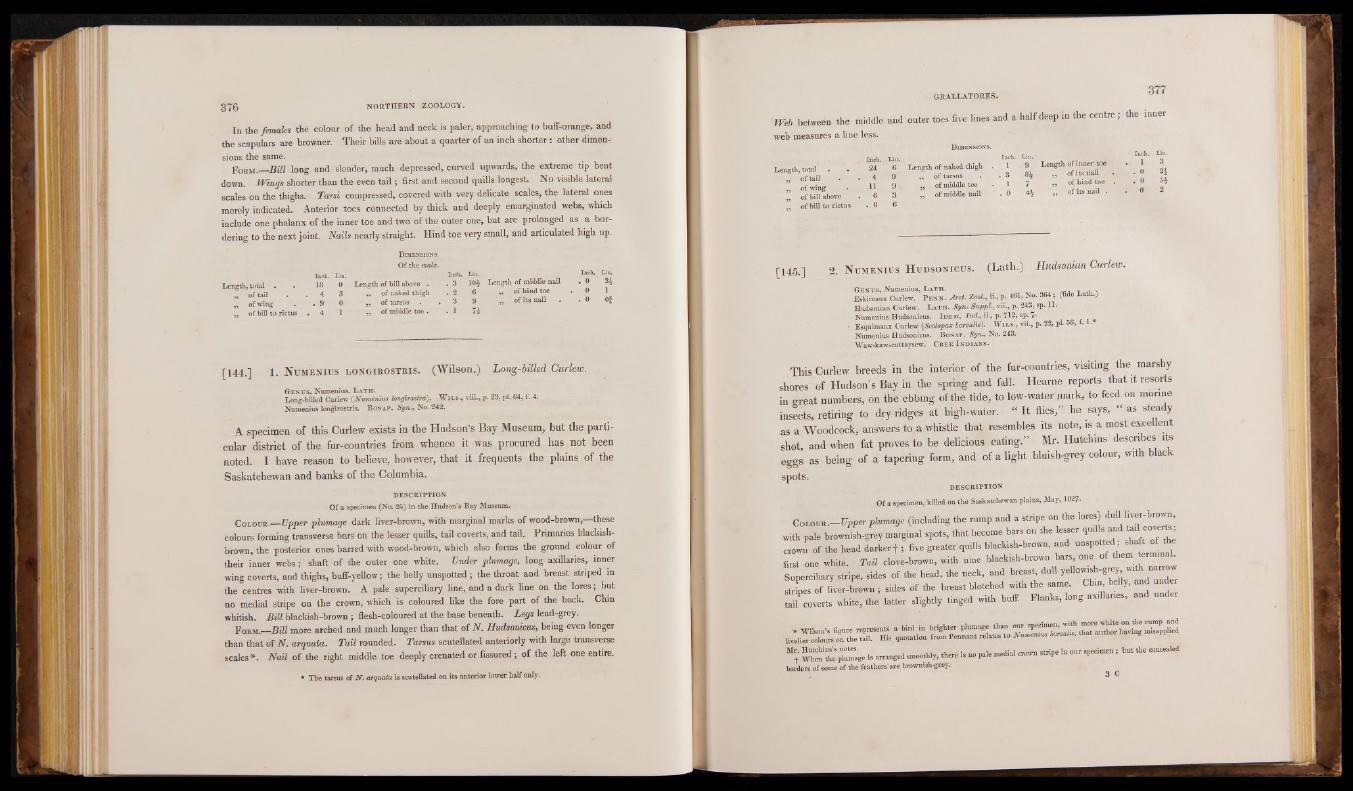
In the females the colour of. the head and neck is paler, approaching to buff-orange, and
the scapulars are browner. Their bills are about a quarter of an inch shorter | other dimen-
sions the same.
Form.__Bill long and slender, much depressed, curved upwards, the extreme tip bent
down. Wings shorter than the even tail; first and second quills longest. No visible lateral
scales on the thighs. Tarsi compressed, covered with very delicate scales, the lateral ones
merely indicated. Anterior toes connected by thick and deeply emarginated webs, which
include one phalanx of the inner toe and two of the outer one, but are prolonged as a bordering
to the next joint. Nails nearly straight. Hind toe very small, and articulated high up.
Length, total
,, of tail
,, of wing .
„ of bill to rictus
Dimensions
Of the male.
18
Lin.
0 Length of bill above . . 3
Lin.
10$
4 3 ,, of naked thigh . 2 6
. 9 0 „ of tarsus . 3 9
4 1 „ of middle toe . 1 1 7è
Length of middle nail
,, of hind toe
,, ...of its nail
Inch, Lin.
. 00 31£ . 0 Of
[144.] 1. N u m e n iu s l o n g ir o s t r is . (Wilson.) Long-billed Ourlew.
Ge n u s , Numenius, L a th . Long-billed Curlew (Numenius longirostra). Wins., viii., p .23, pi. 64, f. 4.
Numenius longirostris. Bonap. Syn., No. 242.
A specimen of this Curlew exists in the Hudson’s Bay Museum, but the particular
district of the fur-countries from whence it was procured has not been
noted. I have reason to believe, however, that it frequents the plains of the
Saskatchewan and banks of the Columbia.
DESCRIPTION
Of a specimen (No: 25) in the Hudson’s Bay Museum.
Colour.—Upper plumage dark liver-brown, with marginal marks of wood-brown,—these
colours forming transverse bars on the lesser quills, tail coverts, and tail. Primaries blackish-
brown, the posterior ones barred with wood-brown, which also forms the ground colour of
their inner webs ; shaft of the outer one white. Under plwmage, long axillaries, inner
wing coverts, and thighs, buff-yellow; the belly unspotted ; the throat and breast striped in
the centres with liver-brown. A pale superciliary line, and a dark line on the lores; but
no medial stripe on the crown, which is coloured like the fore part of the back. Chin
whitish. Bill blackish-brown ; flesh-coloured at the base beneath. Legs lead-grey.
F orm.— Bill more arched and much longer than that of N. Hudsonims, being even longer
than that of N. arquata. Tail rounded. Tarsus scutellated anteriorly with large transverse
scales*. Nail of the right middle toe deeply crenated or fissured; of the left one entire.
* The tarsus of N . arquata is scutellated on its anterior lower half only.
GRALLATORES.
Web between the middle and outer toes five lines and a half deep -in the centre, the inner
web measures a line less.
Length, total •
of tail
„ of wing
„ of bill above
• of bill to rictus
Dimensions.
Inch. ,Lin. Inch.
24 6 Length of naked thigh 1
4 9 ' „ of tarsus . 3
11 9 „ of middle toe . 1
6 3 ’ ’ „ of middle hail ■ . 0
. 6 6
Lin, V
9 Length of inner toe . 1 3
81 of its nail • . 0 2§
7 •„ of hind toe . . 0 5*
4* & „ of its nail . . 0 2
[145.] 2. N u m e n iu s H u d s o n ic u s . (Lath.'m H udsonian Curlew.
Ge n u s , Numenius, L a t h . ■ , . Eskimaux Curlew. P e n h . Arct. Zool, H-, p. 46b No. 364; (fide Lath.)
Hudsonian Curlew. L a t h . Syn. Suppl., vii., p. 243, sp. 11.
Numenius Hudsonicus. I dem, Ind., ii., p. 712, sp. 7- #
' Esquimaux Curlew (Scolopax borealis). W il s ., vii., p. 22, pL 56, . .
Numenius Hudsonicus. B onap. Syn., No. 243.
Waw-kaw-cuttaysew. Cr.e e I n d ia n s .
This Curlew breeds in the interior of the fur-eountnes, visiting the marshy
shores :of Hudson’s Bay in the spring and fall. Hearne reports that it resorts
in great numbers, on thé ebbing of the tide, to low-water mark, to feed on marine
insects, retiring to dry ridges at high-water. “ It flies,” he says, “ as steady
as a Woodcock, answers to a whistle that resembles its note, is a most excellent
shot, and when fat proves to be delicious eating.” Mr. Hutchins describes its
eggs as being of a tapering form, and of a light bluish-grey colour, with black
spots. DESCRIPTION
Of a specimen, killed on the Saskatchewan plains, May, 1827-
Colour.—Upper plumage (including the rump and a stripe on the lores) dull liver-brown,
with pale brownish-grey marginal spots, that become bars on the lesser quills and l I l B f e -
crown of the head darker] i five greater quills blackish-brown, and unspotted; shaf‘ °f
first one white. Tail clove-brown, with nine blackish-brown bars, oneo em
Superciliary stripe, sides of the head, the neck, and breast, dull yellow,sh-grey with narrow
sstnriippeebs ouif Uver-brewn >; sides of the breast blotched with the s.a«m elo. ngC ahxmil labrieelsly, , aanndd uunnddeerr
Mfr. WHuhtcehni nthse’s pnloutmesa.ge is arranged smoothly, there is no
borders of some of the feathersare brownish-grey.
pale medial crown stripe in onr specimen; hut the concealed
3 C